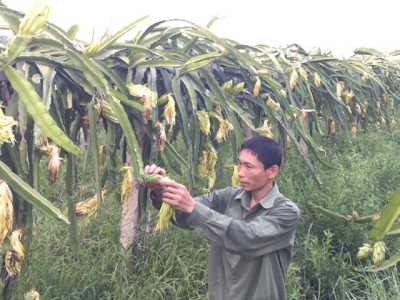Enabling off-season dragon fruit

With his diligence, Nguyen Van Huy (born in 1981) in Thuan hamlet, Tan Thanh commune, Lang Giang district, Bac Giang province has successfully applied the method for off-season red-heart dragon fruit.
The cultivation model of off-season dragon fruit of Nguyen Van Huy’s family in Thuan hamlet, Tan Thanh commune, Lang Giang district.
This time, more than 1,600 red-heart dragon trees of Huy’s family are in good care for the last harvest of the main crop. In the garden, the green dragon-fruit trees have been carefully pruned and fixed.
Huy was removing petals on the young fruits while talking to us. He did it to avoid spoiled fruit infected from the decayed petals. Besides, pruning helps the trees remain nutrition for off-season fruit bearing.
On Lunar New Year 2018, he reaped more than 1.5 tonnes of dragon fruit and sold at a price from 70,000 to 80,000 VND (3 to 3.4 USD) per kilo.
According to the garden owner, it is not difficult to bear off-season dragon fruits. Gardeners should choose strong plants to care for off-season fruits after harvesting the main crop in September. Then, they should cut down weak branches, apply manure and NPK fertilizer.

The off-season dragon fruit orchard.
In middle October, they should treat for flower blossom with light bulbs put in every 2 metre of electric wire. The bulbs should be switched on from morning until overnight for about 20 to 25 days. When dragon fruit trees burst into buds, growers should supply fertilizers for leaves and calcium for trees.
With the initiative of farmer Nguyen Van Huy, dragon fruit trees which were believed to bear fruit only for one crop can come to fruition two crops per year gaining big profits.
Có thể bạn quan tâm
 Agricultural exports rack up US$26 billion in eight months
Agricultural exports rack up US$26 billion in eight months Agro-forestry-aquatic exports brought home US$26.6 billion in the first eight months of this year, representing a year-on-year rise of 1.6 per cent
 CầnThơ build a factory to produce food ingredients from shrimp shells
CầnThơ build a factory to produce food ingredients from shrimp shells After trial cooperation with CầnThơ University, a Japanese company has planned to invest into a factory to produce food ingredients from shrimp shells and heads
 Việt Nam to promote exports of organic fertiliser
Việt Nam to promote exports of organic fertiliser The Ministry of Agriculture and Rural Development has set targets to increase the use of organic fertilisers by the end of next year.